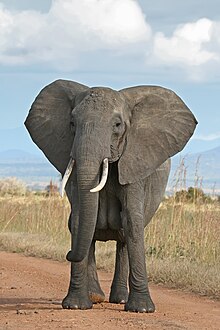Bush elephant
| African bush elephant | |
|---|---|
 |
|
| A female African bush elephant, Loxodonta africana, in Mikumi National Park, Tanzania | |
| Scientific classification | |
| Kingdom: | Animalia |
| Phylum: | Chordata |
| Class: | Mammalia |
| Order: | Proboscidea |
| Family: | Elephantidae |
| Genus: | Loxodonta |
| Species: | L. africana |
| Binomial name | |
|
Loxodonta africana (Blumenbach, 1797) |
|
 |
|
| Distribution of Loxodonta (2007) | |
| Synonyms | |
|
|
The African bush elephant (Loxodonta africana) is the larger of the two species of African elephant.
Both it and the African forest elephant have in the past been classified as a single species, known simply as the African elephant, but recent preliminary evidence has seen the forest elephant classified as a distinct species (although this status is not conclusively accepted due to concerns over conservation strategies until the reclassification is formalised).
The African bush elephant is the largest and heaviest land animal on earth, being up to 3.96 m (13.0 ft) tall at the shoulder and 10.4 tonnes (22,930 lb) in weight (a male shot in 1974, near Mucusso, southern Angola). On average, males are 3.2 metres (10.5 ft) tall at the shoulder and 6 tonnes (13,230 lb) in weight, while females are much smaller at 2.6 metres (8.5 ft) tall at the shoulder and 3 tonnes (6,610 lb) in weight. The most characteristic features of African elephants are their very large ears, which they use to radiate excess heat, and their trunk, a nose and an extension of the upper lip with two opposing extensions, or "fingers" at the end of it (in contrast to the Asian elephant, which only has one). The trunk is used for communication and handling objects and food. African elephants also have bigger tusks, large modified incisors that grow throughout an elephant's life. They occur in both males and females and are used in fights and for marking, feeding, and digging.
Female African bush elephant skeleton on display at the Museum of Osteology, Oklahoma City, Oklahoma
Male African bush elephant skull on display at the Museum of Osteology, Oklahoma City
Skull of a baby African bush elephant
The African bush elephant is herbivorous. Its diet varies according to its habitat; elephants living in forests, partial deserts, and grasslands all eat different proportions of herbs and tree or shrubbery leaves. Elephants inhabiting the shores of Lake Kariba have been recorded eating underwater plant life. To break down the plants it consumes, the African bush elephant has four large molars, two in each mandible of the jaw. Each of these molars is 10 centimetres (4 in) wide and 30 centimetres (12 in) long.
...
Wikipedia

